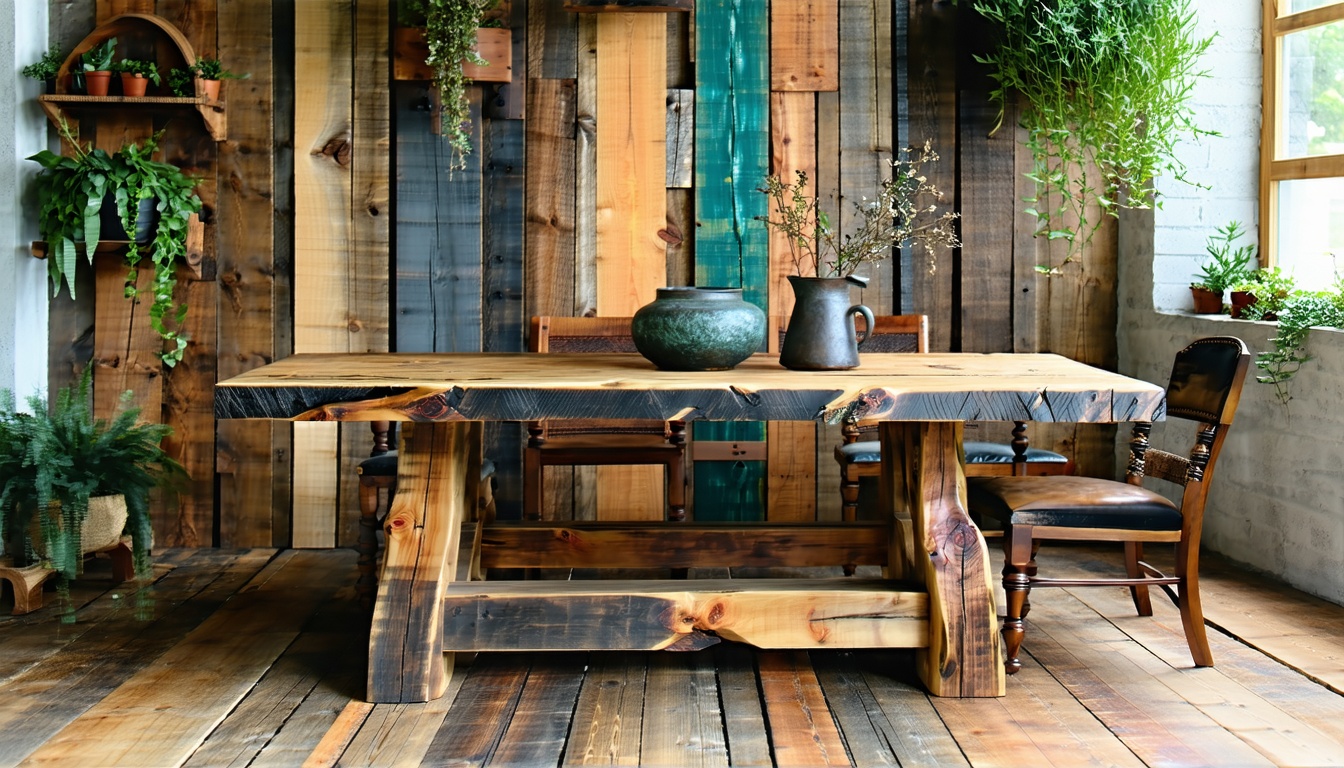Eco-Friendly Materials in Furniture
Let’s chat about furniture that’s good for the planet. You know, stuff that doesn’t just look good but does good too. We’re diving into how using old wood and recyclable metals can make a world of difference in making our furniture more earth-friendly.
Benefits of Using Reclaimed Wood
Reclaimed wood—it’s like giving nature a hug. This stuff comes from old barns or factories and turns into beautiful, storied furniture. It means fewer trees chopped down, so we keep those lush forests standing tall. Bonus: it’s eco-friendly and adds a neat, rustic vibe to your home.
Here’s why people are loving it:
| What’s Cool | Details |
|---|---|
| Eco-Friendly | Keeps the forests alive by chopping down the demand for fresh wood. |
| Unique Look | Each plank tells a tale—perfect for adding a personal touch. |
| Built to Last | It’s solid and sturdy, thanks to years of natural curing. |
| Price Tag | Expect to pay around $10–$20 per board foot. It’s a bit more than $5–$10 for new wood, but you’re paying for charm and eco-friendliness. |
Folks are loving furniture that’s fashionable and kind to Mother Earth. Brands like Cabinfield have loads of options if you’re into that eco-chic look.
Impact of Recycled Metals
Now, let’s talk about metals that won’t cost the earth. Going recycled slashes the harmful side effects of mining and smelting. It’s like the environment’s superhero—using way less energy and generating less pollution.
Here’s the lowdown on using recycled metal:
| Why It Rocks | What’s Happening |
|---|---|
| Energy Saver | Recycling saves about 95% of the energy you’d burn making shiny new metals. |
| Less Trash | Keeps metals out of dumps, which is a win for a cleaner planet. |
| Eco Footprint | Slashing energy usage cuts back on carbon-ness, giving the planet a breather. |
Lending old metal a new lease on life is a hit with the eco-conscious crowd and ties into the bigger picture of sustainable living. Take a peek at some more eco-friendly bits at green living room furniture and environmentally friendly home furnishings.
Reclaimed Wood Furniture
Reclaimed wood furniture is all about merging good looks, staying power, and being kind to Mother Earth. More and more folks are snapping up furniture made from this old woody glory, valuing its vibe and its eco-friendly backbone.
Unique Aesthetics of Reclaimed Wood
Why does reclaimed wood furniture look so darn cool? Because every hunk of it carries a story. It’s like having a piece of the past right in your living room. Those natural aged spots and quirks? Pure gold. They bring out a personality that’s way more charming than cookie-cutter pieces. The colors and textures of this wood just scream class, fitting right into any style of home decor like a glove.
| Aesthetic Features | Description |
|---|---|
| Natural Aging | Shows off a tapestry of character |
| Unique Imperfections | Gives each piece a little soul |
| Rustic Appeal | Wraps rooms in warmth and friendliness |
Plus, using reclaimed wood kinda makes you a time traveler, linking you to history through every knot and grain. It makes spaces, both inside and out, feel homey and personal. If you’re all about keeping things green, why not peek at some eco-smart living room furniture for more ways to spruce up your place?
Durability and Longevity
Let’s talk toughness. Reclaimed wood furniture is built to last. It ain’t your run-of-the-mill factory stuff that falls apart in a few years. This wood’s been through the wringer and come out the other side strong as ever. When you give it a little TLC—cleaning, sanitizing, kiln drying, milling, finishing—it’s ready to stand proudly for generations.
| Treatment Process | Purpose |
|---|---|
| Cleaning | Kicks out the grime and grit |
| Sanitizing | Keeps it safe and sound |
| Kiln Drying | Zaps moisture to stop it from going all wonky |
| Milling | Gets it all ready to shine in new outfit |
| Finishing | Shields the surface, ups the wow factor |
You can score top-notch reclaimed wood from local spots, online treasure hunts, or experts who deal in this stuff. It’s super versatile, letting you find something that matches your taste and needs to a T. Check out more eco-savvy home goods if you want to keep the green good times rolling.
Choosing salvaged wood pieces doesn’t just upgrade your home’s style; it’s a nod to the environment too. And if you’re itching to get creative, maybe some upcycled furniture projects can get those sustainable living juices flowing.
Recycled Materials in Furniture
Here’s the lowdown: Using recycled stuff to make furniture isn’t just smart; it’s a shout-out to sustainable living. This isn’t about a carbon copy of what’s old but making living spaces not just look fab but also feel like Earth-friendly havens.
Contribution to Sustainability
Building new furniture is like running a marathon but with energy—lots of it. Pick something like salvaged wood and watch your guilt levels drop and your cool factor rise. It’s a win-win as it skips the energy-hogging parts of cutting down, hauling, and processing fresh timber. Plus, when you shop local, you’re skipping cross-country treks and cheering for local folks.
Going for urban or reclaimed wood is like the MVP choice in the eco-world. This play saves stuff from rotting in a landfill and gives it a spiffy makeover. Studies—and we love those—show that urban wood players cut their carbon impact and score bragging rights with better carbon-stashing skills than the fresh stuff.
| Furniture Material Type | Energy Used (kWh) | Carbon Footprint Slash (%) |
|---|---|---|
| New Wood Furniture | 1500 | 0 |
| Reclaimed Wood Furniture | 300 | 80 |
| Metal Furniture (Recycled) | 500 | 70 |
Reduced Environmental Impact
Jumping on the recycled material train, like reclaimed wood and metals, is a big slap to the face of our planet’s furniture woes. It’s your ticket to cutting down resource destruction and shrinking that ever-growing landfill monster.
Putting reclaimed wood furniture in your home not only makes it a one-of-a-kind space but shouts “I care!” about being green. Buying from places like Cabinfield says you’re in the eco-gang, plus it’s a toast to local art folks rocking conscious crafting. Amish furniture buyers are like double agents: supporting artisan talent and thinking green.
Reusing what we got means furniture gets a second go and our planet gets a chance. Less trashing Earth’s goodies equals a happier, greener world—for us and the little ones in line. Dive into our tales about eco-friendly pads with green living room furniture and planet-friendly home pretties. Ready to roll up your sleeves? Get crafty with upcycled furniture hacks and keep that green dream alive.
Buying Eco-Friendly Furniture
These days, folks are more interested in living sustainably, so opting for furniture made from eco-friendly stuff like reclaimed wood and recycled metals is a no-brainer. Let’s chat about how to find this reclaimed wood and what to keep in mind when choosing furniture that’s kind to the planet.
Sourcing Reclaimed Wood
Reclaimed wood is like giving old wood a second chance at life. It’s pulled from places like torn-down buildings, weathered barns, old factories, or even logs that have been chilling underwater. This type of wood brings a slice of history to your home without having to chop down new trees.
| Source of Reclaimed Wood | Description |
|---|---|
| Demolished buildings | Old places that lend a unique look |
| Old barns | Often packed with strong, character-rich wood |
| Factories | Industrial wood reimagined for today’s styles |
| Sunken logs | Offers rare, one-of-a-kind colors and patterns |
Finding the right reclaimed wood is like a treasure hunt — you could hit up local salvage yards, browse online markets, or connect with specialized dealers. Each option brings different vibes, qualities, and backstories, giving you plenty of choices for your furniture projects. Furniture made from reclaimed wood showcases the wood’s past and fosters a greener future.
Ethical Considerations in Furniture Production
Picking eco-friendly furniture isn’t just about the materials; it’s also about how it’s made. Look for brands that keep it real with where they get their materials and how they make their stuff.
Here’s what to keep an eye on:
- Sourcing Clarity: Companies should openly share where their materials come from. Items made from reclaimed wood are better for Mother Earth since they reuse what’s already here.
- Fair Labor Practices: It’s gotta be a given that the folks making the furniture are treated right and paid fairly.
- Green Practices: Look for companies using earth-friendly ways to make furniture — cutting down waste, saving energy, and choosing non-toxic finishes and packaging.
Focusing on environmentally friendly home furnishings is a win-win. You get fab furniture that’s stylish and syncs up with your values of sustainability and fairness.

